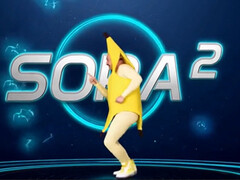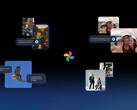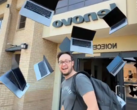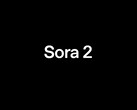Where most AI video models struggle with continuity, Sora 2 understands environmental cause and effect. Shadows shift realistically. Water ripples when something moves near it. Reflections appear in glass and puddles, not at random angles.
OpenAI describes Sora 2 as capable of generating “complex scenes with multiple characters, specific motion, and detailed backgrounds that remain consistent over time.” That’s true — though “consistent” is still a relative term in this world.
Prompt 1: The Central Park duel that fell apart
The first test was deliberately ambitious:
“A peaceful afternoon in New York’s Central Park. Tourists stroll under soft sunlight. Suddenly, a robed figure activates a glowing energy staff and urges people to move to safety. Another, in dark robes, emerges from the trees holding a red weapon. The crowd scatters as the two duel—elegant, dance-like movements, glowing arcs of light reflecting on the water nearby. The camera circles them continuously as autumn leaves swirl in the air.”
What came back was visually striking—soft golden tones, smooth camera rotation, and convincing reflections. But then came the chaos. The glowing staffs (Lightsabers) flickered, bent, and morphed into odd shapes. The fighters’ bodies lost balance, limbs clipping through each other like ghostly polygons from a ’90s video game. The choreography drifted into surreal interpretive dance rather than cinematic combat.
And this flaw isn’t unique to my test. OpenAI has acknowledged that Sora 2 “struggles with sustained, physically plausible humanoid combat or weapon choreography,” a limitation that quickly becomes obvious once weapons start moving.
Still, the surrounding world looked real enough that you could almost forgive it. The scene felt cinematic, even if the action wasn’t.
Prompt 2: The redemption of the Central Park duel
Sora 2 responded to the following prompt rather well.
"A peaceful afternoon in New York’s Central Park. Tourists stroll and take photos under soft golden sunlight. Suddenly, a figure in light-colored robes activates a glowing energy staff and urgently calls for people to move to safety. Another figure in dark robes appears from the trees, holding a red energy weapon. The crowd scatters as the two begin a precise, cinematic duel—elegant, dance-like movements, glowing arcs of light reflecting on the water nearby. The camera circles them in one continuous shot as autumn leaves swirl in the air. No contact or injury is shown—only skillful choreography and dynamic motion."
This time, it actually worked. The movements looked grounded, fluid, and surprisingly human, with a final strike that flows so naturally it’s easy to forget you’re watching something generated by AI.
Prompt 3: Birds and lions at a watering hole
For a calmer test, I turned to wildlife. The prompt:
“Create a wildlife scene where birds and lions are drinking naturally from a watering hole. Every animal should move realistically, and the scene must be hyper-realistic.”
Here, Sora 2 was in its element. The birds fluttered and dipped with believable wing motion. The sunlight shimmered on the water’s surface, and reflections responded naturally as the animals shifted position. The textures—fur, feathers, rippling mud—looked close to nature documentary quality.
Yet the model’s quirks still crept in. One lion ended up awkwardly placed at the muddy edge, appearing to drink directly from the dirt rather than the water. It’s a minor but telling detail: Sora 2 nails the overall scene but sometimes loses track of object-to-surface interaction.
Even so, this was easily the most convincing result—and a hint of where Sora 2’s true strength lies: environmental realism.
Prompt 4: The futuristic rooftop chase
For the final test, I pushed motion, lighting, and atmosphere to their limits:
“A sprawling futuristic cityscape at dawn. A cyberpunk courier in a dark jacket sprints across rooftops, carrying a glowing data case. A pursuing drone weaves between antennas and vents, thrusters flaring blue.
The camera tracks from behind and to the right of the runner, hand-held style, as they leap a gap. The drone overtakes mid-air; lens flare and motion blur complete the scene.”
The output was stunning—and surprisingly cinematic.
The lighting sold it: the sunrise glinting off glass towers, reflections on metal surfaces, and subtle lens flare during the jump. Motion felt fluid and weighty. The drone pursuit introduced genuine tension, while the shallow depth of field mimicked a 35 mm film camera.
This was Sora 2 firing on all cylinders—complex, cohesive, and believable. If this had been released as a teaser for a game or film, most viewers wouldn’t suspect AI involvement at first glance.
The beautiful unpredictability of Sora 2
Across these tests, one truth stood out: Sora 2 is consistently inconsistent. Sometimes, it gets everything right. Other times, it births something so bizarre that you can’t stop laughing. That unpredictability has become part of its charm.
On Reddit, one user summed it up perfectly:
“Sora 2 either gives you Pixar or fever-dream energy, no in-between.”
— r/AIGuild
The model occasionally distorts objects, changes colors mid-scene, or misinterprets prompts in delightfully absurd ways. A prompt for “two plush animals walking side-by-side” once produced creatures that looked half teddy bear, half inflatable balloon. It’s not accurate—but it’s memorable.
That chaos can be a liability for professionals needing reliability, but for creative experimentation, it’s gold. Sora 2 sometimes acts more like a collaborator with an overactive imagination than a predictable machine.
Realism vs. reality: Understanding Sora 2’s strengths
When Sora 2 works, it feels like magic. But it’s not magic—it’s a machine interpreting your words through probability and visual pattern learning. It thrives on context, not precision. Give it a strong sense of place—lighting direction, camera movement, tone—and it fills in the rest convincingly. Ask it for precision-based choreography or fine motor interaction, and it falters.
The pattern matches what others have observed across Reddit and Discord testing groups. Creators note that simpler human actions (walking, looking, gesturing) are believable, but complex sequences (fighting, hugging, playing instruments) break down quickly. That suggests OpenAI’s physics modeling still treats the human body as a set of independent motion clusters rather than a single unit. It’s realistic enough for a few seconds—then entropy takes over.
The broader context: Creativity in the age of algorithms
What makes Sora 2 fascinating isn’t just its technical progress… It’s the cultural shift it represents.
For decades, video creation was expensive, time-consuming, and limited by access to gear or talent. Now, anyone with a good idea and a paragraph of text can produce something visually compelling.
That democratization is powerful—but it also blurs creative authorship. When a model “imagines” part of a scene incorrectly, is that a failure or an interpretation?
In my Central Park duel, the warped weapons ruined realism but introduced a dreamlike quality. It wasn’t what I wanted, yet it hinted at a surreal, painterly aesthetic—something closer to experimental film than Hollywood action.
Maybe that’s the deeper lesson: AI filmmaking isn’t about control. It’s about negotiation.
Technical and ethical boundaries
OpenAI is aware of both the excitement and unease surrounding this tool. The company continues to limit access, citing potential misuse and the need for content safeguards.
Japan’s government recently urged OpenAI to ensure Sora 2 doesn’t infringe on anime and manga copyrights—a reminder that AI’s creative reach comes with real-world legal consequences. Then there’s the question of originality. Sora 2’s outputs may look new, but they’re trained on vast amounts of existing media. The more realistic it becomes, the harder it is to separate homage from replication. That’s why, despite its wonder, Sora 2 sits at a crossroads between artistry and automation.
Audio issues are very noticeable
Most Sora 2 clips still struggle with sound. While the visuals are often stunning, the audio tends to sound poor, flat, muffled, or unnatural. The Sora 2 tries to generate ambient noise, effects, and dialogue all at once, but it can’t separate them the way a real sound designer would. The result is overcompressed, metallic, or strangely balanced audio that rarely matches the cinematic quality of the visuals. For now, the best way to make Sora 2 videos sound good is to add sound in post-production, layering real-world ambience, effects, and music to bring the scene to life.
A glimpse of the future, imperfectly rendered
After days of testing, Sora 2 left me impressed, amused, and a little unsettled. It’s both a marvel of engineering and a reminder that human motion, emotion, and storytelling remain uniquely complex.
Strengths: Environments, lighting, atmosphere, dynamic motion, and realism in short sequences.
Weaknesses: Human contact, weapon physics, occasional surreal distortions.
Does Sora 2 really deliver?
Sora 2 is a pretty decent step toward AI-assisted filmmaking... Just don’t expect flawless realism yet. To add to this, true filmmakers are still the real artists we need... As Sora 2 still struggles with moving the antimony of a human being, as well as animals, in a natural way.
As one Redditor put it:
“Sora 2 feels like watching the future learn how to dream.”
— r/OpenAI
It’s a fitting summary. Sora 2 doesn’t just simulate reality... It experiments with it. And for those of us watching this unfold, that’s both thrilling and profoundly human... Just with extremely bad audio quality.



















